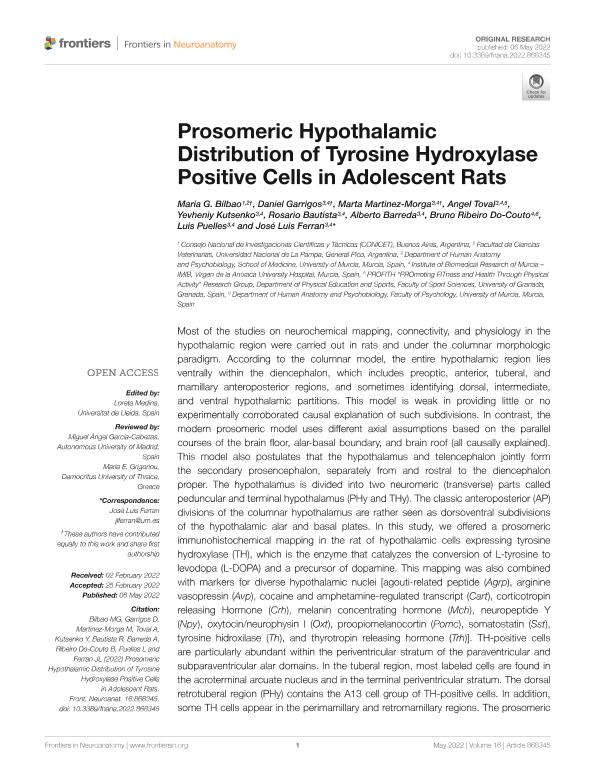Mostrar el registro sencillo del ítem
dc.contributor.author
Bilbao, María Guillermina

dc.contributor.author
Garrigos, Daniel
dc.contributor.author
Martinez Morga, Marta
dc.contributor.author
Toval, Angel
dc.contributor.author
Kutsenko, Yevheniy
dc.contributor.author
Bautista, Rosario
dc.contributor.author
Barreda, Alberto
dc.contributor.author
Ribeiro Do Couto, Bruno
dc.contributor.author
Puelles, Luis
dc.contributor.author
Ferran, José Luis
dc.date.available
2023-10-30T14:06:21Z
dc.date.issued
2022-05
dc.identifier.citation
Bilbao, María Guillermina; Garrigos, Daniel; Martinez Morga, Marta; Toval, Angel; Kutsenko, Yevheniy; et al.; Prosomeric Hypothalamic Distribution of Tyrosine Hydroxylase Positive Cells in Adolescent Rats; Frontiers Media; Frontiers in Neuroanatomy; 16; 5-2022; 1-36
dc.identifier.issn
1662-5129
dc.identifier.uri
http://hdl.handle.net/11336/216374
dc.description.abstract
Most of the studies on neurochemical mapping, connectivity, and physiology in the hypothalamic region were carried out in rats and under the columnar morphologic paradigm. According to the columnar model, the entire hypothalamic region lies ventrally within the diencephalon, which includes preoptic, anterior, tuberal, and mamillary anteroposterior regions, and sometimes identifying dorsal, intermediate, and ventral hypothalamic partitions. This model is weak in providing little or no experimentally corroborated causal explanation of such subdivisions. In contrast, the modern prosomeric model uses different axial assumptions based on the parallel courses of the brain floor, alar-basal boundary, and brain roof (all causally explained). This model also postulates that the hypothalamus and telencephalon jointly form the secondary prosencephalon, separately from and rostral to the diencephalon proper. The hypothalamus is divided into two neuromeric (transverse) parts called peduncular and terminal hypothalamus (PHy and THy). The classic anteroposterior (AP) divisions of the columnar hypothalamus are rather seen as dorsoventral subdivisions of the hypothalamic alar and basal plates. In this study, we offered a prosomeric immunohistochemical mapping in the rat of hypothalamic cells expressing tyrosine hydroxylase (TH), which is the enzyme that catalyzes the conversion of L-tyrosine to levodopa (L-DOPA) and a precursor of dopamine. This mapping was also combined with markers for diverse hypothalamic nuclei [agouti-related peptide (Agrp), arginine vasopressin (Avp), cocaine and amphetamine-regulated transcript (Cart), corticotropin releasing Hormone (Crh), melanin concentrating hormone (Mch), neuropeptide Y (Npy), oxytocin/neurophysin I (Oxt), proopiomelanocortin (Pomc), somatostatin (Sst), tyrosine hidroxilase (Th), and thyrotropin releasing hormone (Trh)]. TH-positive cells are particularly abundant within the periventricular stratum of the paraventricular and subparaventricular alar domains. In the tuberal region, most labeled cells are found in the acroterminal arcuate nucleus and in the terminal periventricular stratum. The dorsal retrotuberal region (PHy) contains the A13 cell group of TH-positive cells. In addition, some TH cells appear in the perimamillary and retromamillary regions. The prosomeric model proved useful for determining the precise location of TH-positive cells relative to possible origins of morphogenetic signals, thus aiding potential causal explanation of position-related specification of this hypothalamic cell type.
dc.format
application/pdf
dc.language.iso
eng
dc.publisher
Frontiers Media

dc.rights
info:eu-repo/semantics/openAccess
dc.rights.uri
https://creativecommons.org/licenses/by-nc-sa/2.5/ar/
dc.subject
A13 GROUP
dc.subject
ACROTERMINAL HYPOTHALAMUS
dc.subject
ARCUATE NUCLEUS
dc.subject
HYPOTHALAMIC DOPAMINE
dc.subject
PARAVENTRICULAR NUCLEUS
dc.subject
PEDUNCULAR HYPOTHALAMUS
dc.subject
POMC
dc.subject
TERMINAL HYPOTHALAMUS
dc.subject.classification
Biología

dc.subject.classification
Ciencias Biológicas

dc.subject.classification
CIENCIAS NATURALES Y EXACTAS

dc.title
Prosomeric Hypothalamic Distribution of Tyrosine Hydroxylase Positive Cells in Adolescent Rats
dc.type
info:eu-repo/semantics/article
dc.type
info:ar-repo/semantics/artículo
dc.type
info:eu-repo/semantics/publishedVersion
dc.date.updated
2023-10-27T16:16:46Z
dc.journal.volume
16
dc.journal.pagination
1-36
dc.journal.pais
Suiza

dc.journal.ciudad
Basel
dc.description.fil
Fil: Bilbao, María Guillermina. Universidad Nacional de La Pampa. Facultad de Ciencias Veterinarias; Argentina. Consejo Nacional de Investigaciones Científicas y Técnicas. Centro Científico Tecnológico Conicet - Patagonia Confluencia; Argentina
dc.description.fil
Fil: Garrigos, Daniel. Universidad de Murcia; España
dc.description.fil
Fil: Martinez Morga, Marta. Universidad de Murcia; España
dc.description.fil
Fil: Toval, Angel. Universidad de Murcia; España
dc.description.fil
Fil: Kutsenko, Yevheniy. Universidad de Murcia; España
dc.description.fil
Fil: Bautista, Rosario. Universidad de Murcia; España
dc.description.fil
Fil: Barreda, Alberto. Universidad de Murcia; España
dc.description.fil
Fil: Ribeiro Do Couto, Bruno. Universidad de Murcia; España
dc.description.fil
Fil: Puelles, Luis. Universidad de Murcia; España
dc.description.fil
Fil: Ferran, José Luis. Universidad de Murcia; España
dc.journal.title
Frontiers in Neuroanatomy
dc.relation.alternativeid
info:eu-repo/semantics/altIdentifier/url/https://www.frontiersin.org/articles/10.3389/fnana.2022.868345/full
dc.relation.alternativeid
info:eu-repo/semantics/altIdentifier/doi/https://doi.org/10.3389/fnana.2022.868345
Archivos asociados
